Related Research Articles

Smallville is a fictional town in American comic books published by DC Comics. The childhood hometown of Superman, Smallville was first named in Superboy #2. The town is the setting of many Superboy comics where Superboy defends Smallville from various threats.

The Phantom Zone is a prison-like parallel dimension appearing in American comic books published by DC Comics. It is mainly associated with stories featuring Superman. It first appeared in Adventure Comics #283, and was created by Robert Bernstein and George Papp. It was frequently used in the Superman comics before the continuity was rebooted in the 1980s, after Crisis on Infinite Earths, and has appeared occasionally since.

Bizarro is a supervillain/anti-hero appearing in American comic books published by DC Comics. The character was created by writer Otto Binder and artist George Papp as a "mirror image" of Superman, and first appeared in Superboy #68 (1958). Debuting in the Silver Age of Comic Books, the character has often been portrayed as an antagonist to Superman, though on occasion he also takes on an anti-hero role.

Superboy is the name of several fictional superheroes appearing in American comicbooks published by DC Comics. These characters have been featured in several eponymous comic series, in addition to Adventure Comics and other series featuring teenage superhero groups.
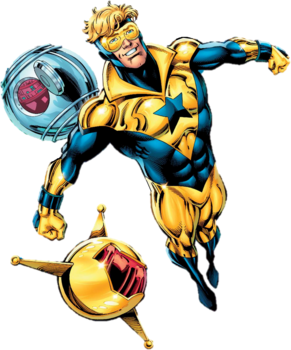
Booster Gold is a superhero appearing in American comic books published by DC Comics. Created by Dan Jurgens, the character first appeared in Booster Gold #1 and has been a member of the Justice League.
See also: 1964 in comics, 1966 in comics, 1960s in comics and the list of years in comics

Adam Strange is a fictional space adventurer appearing in American comic books published by DC Comics. Created by editor Julius Schwartz with a costume designed by Murphy Anderson, he first appeared in Showcase #17.
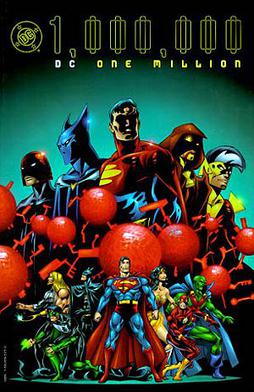
"DC One Million" is a comic book crossover storyline that ran through a self-titled, weekly miniseries and through special issues of almost all of the "DCU" titles published by DC Comics in November 1998. It featured a vision of the DC Universe in the 853rd century, chosen because that is the century in which DC Comics would have published issue #1,000,000 of their comics if they had maintained a regular publishing schedule. The miniseries was written by Grant Morrison and drawn by Val Semeiks.
Mister Mind is a supervillain appearing in American comic books published by DC Comics. Created by Otto Binder and C. C. Beck for Fawcett Comics, he made a cameo appearance in Captain Marvel Adventures #22 before making his full first appearance in Captain Marvel Adventures #26. One of Captain Marvel's greatest enemies, Mister Mind is a two-inch alien caterpillar of high intelligence with telepathic powers who usually carries out his villainous plans through an organization called the Monster Society of Evil. The Monster Society of Evil made its debut in Captain Marvel Adventures #22, and the resulting "Monster Society of Evil" story arc continued for two years in Captain Marvel Adventures, ending with issue #46.
Arnold Drake was an American comic book writer and screenwriter best known for co-creating the DC Comics characters Deadman and the Doom Patrol, and the Marvel Comics characters the Guardians of the Galaxy, among others.
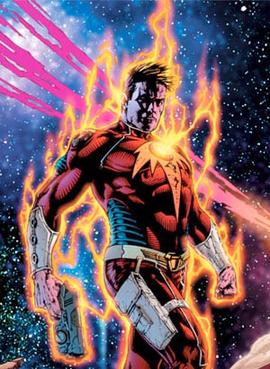
Captain Comet is a superhero appearing in American Comic Books published by DC Comics, created by editor Julius Schwartz, writer John Broome, and artist Carmine Infantino.

52 is a weekly American comic book limited series published by DC Comics that debuted on May 10, 2006, one week after the conclusion of the Infinite Crisis miniseries. The series was written by Geoff Johns, Grant Morrison, Greg Rucka, and Mark Waid, with layouts by Keith Giffen. 52 also led into a few limited series spin-offs.
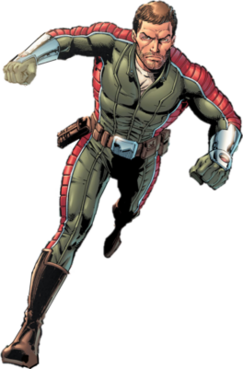
Rip Hunter is a time-traveling superhero appearing in American comic books published by DC Comics. Created by writer Jack Miller and artist Ruben Moreira, the character first appeared in Showcase #20. Following three more appearances in Showcase, Rip Hunter was given his own series which ran for 29 issues (1961–65). He later starred in the eight-issue Time Masters series (1990), written by Bob Wayne and Lewis Shiner. After numerous revisions and following the events of the 2005 "Infinite Crisis" storyline, Hunter is established as the son of Booster Gold.
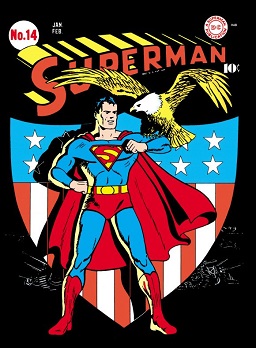
Superman is an American fictional character that appears in DC Comic books. He debuted in Action Comics issue #1 in June 1938. This character has become a defining superhero.
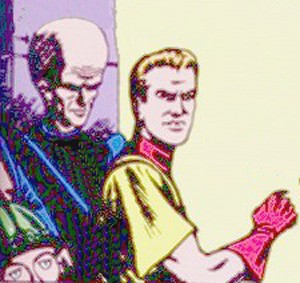
Chris KL-99 is a 1950s science fiction comic book character whose adventures were published by National Comics, now known as DC Comics. He first appeared in Strange Adventures #1, and was created by science fiction author Edmond Hamilton and artist Howard Sherman.
The Official DC Index is a series of comic books released by Independent Comics Group from 1985 to 1988, which featured synopses of several DC Comics series. The books, edited by Murray Ward, would often feature background information on the main characters in a particular series, and detailed information on each issue, including writer and artist credits, characters who appeared in the issue, and a story synopsis. A similar series of indices called the Official Marvel Index was published by Marvel Comics.

Superboy is a superhero that appears in American comic books published by DC Comics. The character was created by Jerry Siegel and Don Cameron and is based on the character of Superman that Siegel co-created with Joe Shuster. Superboy first appeared in the comic book More Fun Comics #101 in 1945.

The origin of Superman and his superhuman powers have been a central narrative for Superman since his inception, with the story of the destruction of his home planet, his arrival on Earth and emergence as a superhero evolving from Jerry Siegel's original story into a broad narrative architype over the course of Superman's literary history and as the character's scope continues to expand across comics, radio, television and film.

DC Universe: Legacies is a 2010–2011 ten-issue comic book limited series written by Len Wein and published by DC Comics. It details the perspective of an admirer of superheroes in the DC Universe from the Golden, Silver, Bronze, and Modern eras of comic books.
References
- ↑ Markstein, Don. "Space Museum". Don Markstein's Toonopedia. Retrieved 2 April 2020.
- ↑ Booster Gold #6 (July 1986).
- ↑ "From the Depths - The Secret Origin of Booster Gold", Secret Origins vol. 2 #35 (1988); Adventures of Superman #476 (March 1991); Booster Gold vol 2 #1, (October 2007) and others.
- ↑ Unusually for comics of the day, Tommy ages almost in 'real time'; he has several named birthday visits to the Museum and is clearly drawn physically older in later issues.
- ↑ Booster Gold #6 (July 1986).
- ↑ The opening story of the series, "The World of Doomed Spacemen", Strange Adventures #104 (May 1959).
- ↑ "The World of Doomed Spacemen", Strange Adventures #104 (May 1959).
- ↑ "Secret of the Tick-Tock World", Strange Adventures #109 (October 1959).
- ↑ "Revolt of the Spaceships", Strange Adventures #112 (January 1960).
- ↑ "The Gem Invasion of Earth", Strange Adventures #115 (April 1960).
- ↑ "The Billion-Year Old Spaceship", Strange Adventures #121 (October 1960).
- ↑ "Earth Victory - By a Hair", Strange Adventures #124 (January 1961).
- ↑ "The Toy Soldier War", Strange Adventures #130 (July 1961).
- ↑ "The Immortal Spaceman!", Strange Adventures #133 (Oct 1961).
- ↑ "Second-Best Spaceman!", Strange Adventures #136 (Jan 1962).
- ↑ "Secret of the Energy Weapon!"", Strange Adventures #139 (Apr 1962).
- ↑ "Prisoners of the Space Flowers", Strange Adventures #142 (July 1962).
- ↑ "The Evolutionary Ensign of Space", Strange Adventures #148 (January 1963).
- ↑ "Rescue By Moonlight", Strange Adventures #157 (October 1963).
- ↑ "The Mass Energy Robbers of Space", Strange Adventures #145 (October 1962).
- ↑ "The Startling Secret of The Space Museum", Secret Origins #50 (August 1990). Some of the relics he took are the same as referred to in the original Strange Adventures series - the contact lenses from "The World of Doomed Spacemen", Strange Adventures #104 (May 1959), the jewel from "Secret of the Space Jewel", Strange Adventures #106 (July 1959), the toy soldier from "Toy Soldier War", Strange Adventures #130 (July 1961) and the ray-gun from "Threat of the Planet Wreckers", Strange Adventures #118 (July 1960).
- ↑ "Threat of the Planet Wreckers", Strange Adventures #118 (July 1960).
- ↑ Hence his nickname - General 'Wrecker' Parker.
- ↑ "The Startling Secret of The Space Museum", Secret Origins #50 (August 1990)
- ↑ "To Cross the Rubicon", Booster Gold #6 (July 1986).
- ↑ This is around the time Tommy's visits to the Space Museum begin - he is specifically known to be aged about 15-16 in "Second-Best Spaceman", Strange Adventures #136 (January 1962) - which is dated to 2471, so would have been 6 or 7 in 2462. There is an oblique reference to Tommy in Booster Gold's origin in Booster Gold #6 from July 1986: "It was the enthusiasm of the children, I believe, on hearing tales of past adventures from their parents, that impressed Booster so deeply", coupled with frames showing a father and his young son going to the museum and looking at the exhibits.
- ↑ Originally Dan Jurgens had planned to have Booster Gold as one of the custodians of the Superman Museum who went back in time to show Superman how he should be a super-hero, but John Byrne's revamp of the Superman character meant a different origin was required - "Secrets Behind the Origins", a text piece by Mark Waid in Secret Origins #35 (1986).
- ↑ "The Secret That Time Forgot", Justice League of America #206.
- ↑ "The Mass Energy Robbers of Space", Strange Adventures #145 (October 1962).
- ↑ Starman vol. 2, #55 (1999). Note: there is no clue as to where in DC continuity this James Robinson penned homage to the old Strange Adventures and Mystery in Space characters and stories fits.
- ↑ New Adventures of Superboy #50 (February 1984). Note: no longer part of DC Universe continuity since the ret-con removal of Superboy.
- ↑ A number of Internet sources state that The Time Trapper later either stole the second H-Dial, or it was stolen by Lori Morning of The Legion, but there does not appear to be any reference for this.
- ↑ "When Robots Attack", Legionnaires #68 (Feb 1999) - in which the Museum is shown to contain some inaccurate replicas of the Metal Men - Tin is a dog (in a confusion with Rin Tin Tin), and Jay 'The Flash' Garrick is a member. It also exhibits Star Hawkins' robot assistant Ilda, both the Golden Age Robotman and the Doom Patrol's Robotman exoskeltons, one of the G.I. Robots from Weird War Tales , a Cyberman and a Dalek (from Doctor Who ), and the power lantern of Alan Scott the original Green Lantern.
- ↑ Twilight #1-3 (December 1990 - January 1991).
- "A Series of Strange Adventures", by DC Comics Editor Jack C. Harris, The Amazing World of DC Comics, #12 (July 1976) (DC Comics) (note: issue says August 1976 on cover, but July 1976 in indicia).
- "A visit to the Space Museum" by Gleeson, Tony - article in Comic Book Marketplace #75 (Gemstone Publishing, January 2000).
- Space Museum entry in "The Silver Age Companion" by Barr, Michael (TwoMorrows Publishing, 2007) ISBN 1-893905-81-0